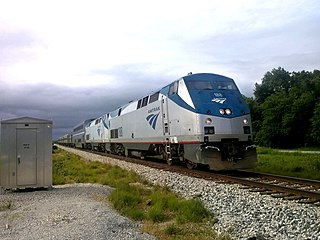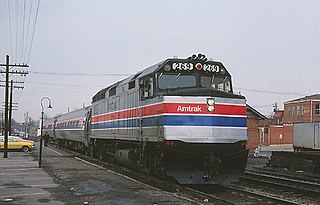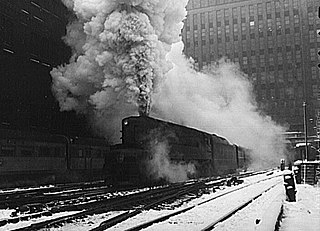
The Broadway Limited was a passenger train operated by the Pennsylvania Railroad (PRR) between New York City and Chicago. It operated from 1912 to 1995. It was the Pennsylvania's premier train, competing directly with the New York Central Railroad's 20th Century Limited. The Broadway Limited continued operating after the formation of Penn Central (PC) in February 1968, one of the few long-distance trains to do so. PC conveyed the train to Amtrak in 1971, who operated it until 1995. The train's name referred not to Broadway in Manhattan, but rather to the "broad way" of PRR's four-track right-of-way along the majority of its route.

The Cardinal is a long-distance passenger train operated by Amtrak between New York Penn Station and Chicago Union Station via Philadelphia, Washington, D.C., Charlottesville, Charleston, Huntington, Cincinnati, and Indianapolis. Along with the Capitol Limited and Lake Shore Limited, it is one of three trains linking the Northeast and Chicago. Its 1,146-mile (1,844 km) trip between New York and Chicago takes 281⁄4 hours.

Central Station was an intercity passenger terminal in downtown Chicago, Illinois, at the southern end of Grant Park near Roosevelt Road and Michigan Avenue. Owned by the Illinois Central Railroad, it also served other companies via trackage rights. It opened in 1893, replacing Great Central Station, and closed in 1972 when Amtrak rerouted services to Union Station. The station building was demolished in 1974. It is now the site of a redevelopment called Central Station, Chicago.
The Colonial, also known as the Colonial Express, was a service of the Pennsylvania Railroad and New York, New Haven and Hartford Railroad between Union Station in Washington, DC and South Station in Boston, Massachusetts. It was operated until 1973 by Amtrak.

The Floridian was a train operated by Amtrak from 1971 to 1979 that ran between Chicago and Florida, with two branches south of Jacksonville terminating at Miami and St. Petersburg. For its Nashville to Montgomery segment, its route followed that of several former Louisville & Nashville Railroad (L&N) passenger trains, including the Pan-American and the Humming Bird. Originating in Chicago, the train served Lafayette and Bloomington, Indiana; Louisville and Bowling Green, Kentucky; Nashville, Tennessee; Decatur, Birmingham, Montgomery and Dothan, Alabama; and Thomasville, Valdosta and Waycross, Georgia.

The Charlottesville Union Station, located in Charlottesville, Virginia, United States, is served by Amtrak's Cardinal,Crescent, and daily Northeast Regional passenger trains. It is Amtrak's third-busiest station in Virginia, aside from its all-auto Auto Train station in Lorton. The station is situated in the northeast quadrant of the junction between two railway lines. The Cardinal uses the east–west line, owned by the state of Virginia, and formerly by CSX Transportation, and operated by the Buckingham Branch Railroad, while other services use the north–south line owned and operated by Norfolk Southern Railway. The station is within walking distance of the University of Virginia, which is the major employer in the area.

The George Washington was a named passenger train of the Chesapeake and Ohio Railway running between Cincinnati, Ohio and Washington, D.C. that operated from 1932, the 200th anniversary of the birth of George Washington, to 1974. A section divided from the main train at Gordonsville, Virginia and operated through Richmond to Phoebus, Virginia. From the west, a section originated in Louisville and joined at Ashland.

Newport News station is an Amtrak intercity train station in Newport News, Virginia. The station is the southern terminus of two daily Northeast Regional round trips. It has a single side platform adjacent to a large CSX rail yard. An Amtrak Thruway motorcoach connection to Norfolk station effectively doubles the frequency between each station and Washington.

South Portsmouth–South Shore station is an Amtrak intercity rail station in South Shore, Kentucky. It primarily serves the city of Portsmouth, Ohio, located across the Ohio River.

The Hoosier State was a 196-mile (315 km) passenger train service operated by Amtrak between Chicago and Indianapolis. It ran on the four days each week that the Cardinal did not run, giving daily rail service to the Chicago–Indianapolis corridor.

The Hilltopper was a passenger train operated by Amtrak in the Mid-Atlantic region of the United States. It ran daily from South Station in Boston, Massachusetts to Catlettsburg station in Catlettsburg, Kentucky. The 1,674 mi (2,694 km) run made 34 stops in 11 states and the District of Columbia.

The Shenandoah was a daily passenger train operated by Amtrak between Washington and Cincinnati from 1976 until 1981.

The Manhattan Limited was a passenger train of the Pennsylvania Railroad which served the Chicago—New York City route.

The New England States was a passenger train operated by the New York Central Railroad and its successor Penn Central over the Water Level Route between Chicago and Boston. It was launched in 1938, in tandem with the relaunch of the newly-streamlined 20th Century Limited, and assumed responsibility for that train's Boston sleepers. In 1949 it became the first Chicago–Boston streamliner. The New York Central dropped the name in 1967; an unnamed remnant continued running until 1971. Amtrak's Lake Shore Limited now serves the route.

The National Limited was a passenger train that ran between Kansas City, Missouri, and both New York City and Washington, D.C., splitting in Pennsylvania. Amtrak operated the train from 1971 to 1979.
The Fast Flying Virginian (FFV) was a named passenger train of the Chesapeake & Ohio Railway.

The Mountaineer was a passenger train operated by Amtrak between Norfolk, Virginia, and Chicago, Illinois, via Cincinnati, Ohio. It was the first train to use the Norfolk and Western Railway's tracks since the creation of Amtrak in 1971 and followed the route of the Pocahontas, the N&W's last passenger train. Service began in 1975 and ended in 1977. A new train, the Hilltopper, operated over much of the Mountaineer's route but was itself discontinued in 1979.
The Night Owl was a passenger train operated by Amtrak on the Northeast Corridor between Washington, D.C., and Boston, Massachusetts, via New York City. It operated from 1972 to 1995 on an overnight schedule with sleeper service; it was the only such train on the Northeast Corridor. In 1995 Amtrak dropped most individual train names from its Northeast Corridor services and the Night Owl became another NortheastDirect service, but still on an overnight schedule. Amtrak replaced it with the Twilight Shoreliner in 1997.

The Colonial was an Amtrak intercity passenger train that operated between Boston, Massachusetts, and Newport News, Virginia, from 1976 to 1992. It was introduced on June 15, 1976, to replace the lightly-used Charlottesville-Newport News section of the James Whitcomb Riley. Certain trips were known as the Senator and Tidewater beginning in the late 1970s. The Richmond-New York City Virginian was added in 1984, with some trips called Potomac from 1985 to 1988.

Cincinnati River Road station was an Amtrak intercity rail station located south of River Road west of downtown Cincinnati, Ohio. It opened in October 1972 to replace the underused Cincinnati Union Terminal, and closed in July 1991 when Amtrak moved service back to the restored Union Terminal.




















